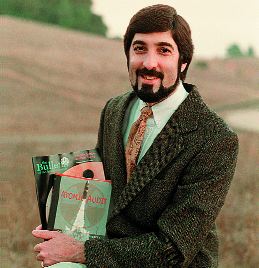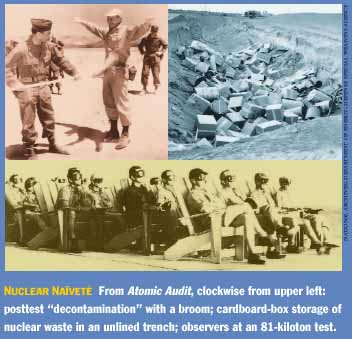 Atomic
Accountant
Atomic
Accountant Atomic
Accountant
Atomic
AccountantI magine a stack of $1 bills, stretching to the moon and nearly back again. According to UCSC alumnus Stephen Schwartz, that's one way to visualize how much money– $5.5 trillion–the United States spent on building and maintain-ing its nuclear stockpile and nuclear weapons infrastructure from 1940 to 1996.
That's more than was spent on medicare, education, or any other government expenditure except for social security ($7.9 trillion) and nonnuclear national defense ($13.2 trillion).
Whether the $5.5 trillion was money well spent is a matter of debate. Depending on one's perspective, it either prevented World War III or exacerbated Cold War tensions between the United States and the former Soviet Union.
What isn't debatable, argues Schwartz in a Brookings Institution book he edited and coauthored, is that the U.S. government made few attempts to track its spending on nuclear weapons and weapons-related programs. Schwartz says this lack of fiscal oversight kept the American public and its representatives in Washington, D.C., from making fully informed decisions during a massive and dangerous nuclear arms race.
"For 50-plus years, since the bombing of Hiroshima and Nagasaki, we've been arguing over the benefits of nuclear weapons, and we haven't had the opportunity to weigh the costs," Schwartz says. "Now, for the first time, you can really balance the ledger, weigh the pros and cons, and have a balanced debate."
Schwartz's book, Atomic Audit: The Costs and Consequences of U.S. Nuclear Weapons Since 1940, was published by Brook-ings Institution Press last June. Newspapers and magazines in-cluding the Washington Post, the New York Times, and U.S. News & World Report carried articles about the book and editorials debating its conclusions.
A Los Angeles Times book reviewer called Atomic Audit a "giant step. . .toward integrity" in America's history with nuclear weapons. "It is only through the unflinching study of our past behavior that we can expect to create a more humane and demo-cratic future," the reviewer wrote.
Included in the study is a description of the nuclear tests, the human-radiation experi-ments, the gaps in congressional oversight, and the na•vetˇ with which government and military officials approached the use of nuclear weapons and the dispos-al of radioactive materials.
Now publisher of The Bulletin of the Atomic Scientists, Schwartz says
his interest in nuclear policy dates back to his days at UCSC.  As
a freshman, he planned to major in theater and film, but was hooked instead
by the Adlai E. Stevenson Program on Nuclear Policy, since renamed the Stevenson
Program on Global Security.
As
a freshman, he planned to major in theater and film, but was hooked instead
by the Adlai E. Stevenson Program on Nuclear Policy, since renamed the Stevenson
Program on Global Security.
"My whole undergraduate education got skewed toward nuclear weapons," says Schwartz, who became a senior research assistant at the Stevenson pro-gram and helped write a hand-book on nuclear weapons. Schwartz also wrote an 80-page "nuclear primer" and won a Chancellor's Undergraduate Award for his senior thesis, which discussed whether–and how– to teach nuclear issues in grade school.
His UCSC projects helped prepare Schwartz for the exhaus-tive research required for Atomic Audit. Over a four-year period, he and nine contributing authors waded through archives, pushed to get documents declassified, dug into mountains of statistics, and read hundreds of "old, musty" reports, he said.
The United States embraced nuclear weapons in the late 1940s and early-to-mid 1950s in large measure because nuclear weapons were considered to be a relatively inexpensive alternative to conven-tional weapons.
Schwartz's book itemizes the costs associated with that decision (expressed in 1996 dollars after adjustments for infla-tion). Included in the $5.5 trillion total are $409 billion to manufacture nuclear warheads and $3.2 trillion for the aircraft, missiles, submarines, and other delivery systems needed to deploy them.
The costs continue to add up, according to Atomic Audit: The U.S. maintains an arsenal of 10,000 nuclear weapons– many still poised on hair-trigger alert–at a current cost of $25 billion a year.
–Francine Tyler
Top photo: Don Harris